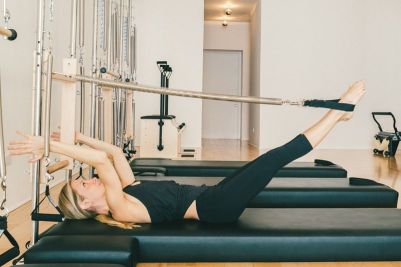I love when some insights about ourselves come to us through physical experiences. One clear example happened a couple of times last week in a Pilates studio. The exercise I was teaching is called “leg springs”. It looks more or less like this (I use slightly different settings).

The person moves the legs up and down. The springs give some resistance when the legs pull them down. What happens often is that the pelvis starts tilting anteriorly and the lower back starts arching as the legs go lower.
Now every teacher teaches different ways according to an intention that comes with an exercises for the particular client, or just different ways of understanding movement. So what I am going to state here is my way of teaching and there are many other ways. With the leg springs exercise, I tend to emphasise the stability of the pelvis. The pelvis and the lower back have to be stable as they are while the legs go down. Depending on the strength and also the proprioception (the sense through which we perceive the position and movement of the body) of the person, some can bring the legs all the way down without moving the pelvis, others not. And both are ok by me. How far the legs go is not the matter. My question is “Can you feel the edge just where the pelvis is about to tilt? Can you stop taking the legs down just before?” And this seems to give a clear idea for most of people. As they repeat the movement (as we usually do in Pilates), I encourage them to carefully push the edge a little further without losing the stability of the pelvis, which will bring a progress in their proprioception and strength.
Y has been practicing Pilates for several years and also received a few Craniosacral Therapy treatments. For Y, this instruction immediately rang the bell beyond the exercise into more internal self-awareness. “That is my problem!” She talked about her difficulties to set boundaries to some people around her. Do we help someone until the point that we feel we are used? Do we listen to someone even when we feel suffocated and cannot express ourselves any longer? These are the examples. We need a boundary somewhere. It helps to know where the edge is in ourselves. How much can we stretch ourselves while maintaining ourselves fully alive.
The next day, I went to Aikido, a Japanese martial art, training. The teacher told me “Don’t sacrifice your posture to do the technique!” Oh yes, this is the same thing. If I lose my posture and go off balance, I would fall with my partner who I made fall.
A fascinating fact about getting some insight from physical experiences is that we can feel the quality of it. When we pull down the leg spring, we feel how the tension increases nearer the edge. When we push over a partner in Aikido, we feel how calm and centred we can be even though the partner may fall dynamically . These experiences subconsciously give us some clues about how it feels like in our bodies to be near to the edge or boundary, and to step over the edge and losing the balance.
We can learn about the boundaries by talking, listening and reading intellectually. But there is nothing more powerful than embodied knowing through the body. The body is very intelligent in its way, and it holds lots of truth about ourselves.
this is a lovely example of how when we listen carefully to the body we can repattern from the inside out! thank you Katsura
LikeLike
Thanks Celia for your comment! The body is so fascinating in that way. I would love to learn more.
LikeLike